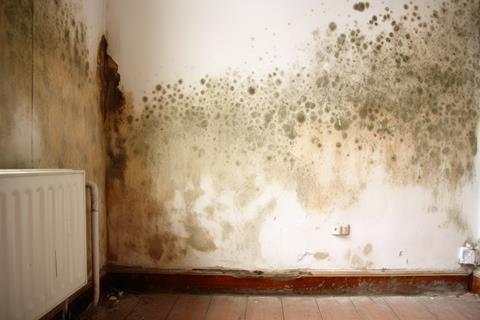The watchdog has shared more than 100 severe maladministration cases on damp and mould ahead of Awaab’s Law being introduced.
Landlord inspections of damp and mould in 100 cases of severe maladministration were limited or repeated several times before action was taken, causing delays in addressing the issue, according to the Housing Ombudsman.

Richard Blakeway added that a disconnect between survey recommendations and the schedule of works further contributed to these delays.
The Ombudsman’s report latest report dentified key problems in the sector in dealing with damp and mould, including delays in initial inspections, starting repairs, and completing work.
Under Awaab’s Law, social and private landlords will be required to make emergency repairs within 24 hours, investigate hazards within 14 days, and begin repairs within seven days.
>> See also: Scottish housing regulator proposed three new damp and mould performance indicators for social landlords
>> See also: Repairs spend up as social housing providers prioritise mould and building safety
Blakeway said failing to address damp and mould can increase costs for landlords, both in terms of higher repair expenses and the cost of compensating affected residents.
In some cases, the Ombudsman orders landlords to pay compensation based on the rent charged during the period of service failure, stating it is “not a rent rebate, but a way to assess the loss of enjoyment of the home”.
Blakeway added that landlords need to re-consider approaches to compensation, saying, “It is wholly unreasonable to offer just £150 to a resident who lost both their bedrooms to mould for more than a year, as happened in one case.”
In one case, a Peabody resident lived in a property affected by damp and mould for two years, which left them unable to sleep in their bedroom. The Ombudsman found that Peabody did not take into account the resident’s disability and its repairs records were “poor”. This made it difficult to understand how the landlord reached its conclusions, such as stating that the mould was “minor”.
Peabody offered the resident £500 in compensation at stage one of the complaints process, increasing this to £950 in its final response.
The Ombudsman instructed Peabody to apologise to the resident and pay a total of £8,724 in compensation, part of which was calculated based on the rent charged during the time the resident’s enjoyment of their home was impacted by damp and mould.
In response, Peabody said that “in the past few years, we have made significant changes to how we manage damp and mould repairs and have formed specialist complaints and record handling teams who make sure that any issues are handled promptly”.
In another case involving L&Q, the Ombudsman made a severe maladministration finding and ordered the housing association to pay £9,000 in compensation after it failed to deal with damp and mould for four years.
The Ombudsman noted that the damp and mould issue was still outstanding when he issued the severe maladministration finding.
L&Q took eight months to inspect the issue, despite the resident’s repeated follow-ups. The Ombudsman ordered L&Q to pay £9,000 in compensation, noting that their initial offers did not adequately recognise the impact of the issue on the resident.
L&Q said “we are sorry for how long it took us to put things right for the resident in this case”, adding that it is delivering a 15-year, £3bn home improvement programme to invest in its homes and services.
Other landlords named in the report were:
- Bromford
- Clarion
- Croydon Council
- Curo Group
- Islington Council
- Kingston upon Thames Council
- Lewisham Council
- Barking and Dagenham Council
- Longhurst Group
- Metropolitan Thames Valley
- Moat Homes
- PA Housing
- Places for People
- Sanctuary
- Southwark Council
- Sovereign Network Homes
- Swindon Council
- Waltham Forest Council











No comments yet